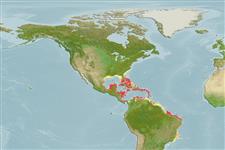>
Ovalentaria/misc (Various families in series Ovalentaria) >
Pomacentridae (Damselfishes) > Microspathodontinae
Etymology: Stegastes: Greek, stegastos, -e, -on = covered (Ref. 45335).
More on authors: Jordan & Rutter.
Environment: milieu / climate zone / depth range / distribution range
Ecologia
marinhas associadas(os) a recifes; não migratória; intervalo de profundidade 2 - 45 m (Ref. 9710), usually 2 - 5 m (Ref. 9710). Tropical
Western Atlantic: southern Florida (USA), Bahamas, and Caribbean Sea. Including Antilles and Yucatan to Venezuela (Ref. 26938).
Tamanho / Peso / Idade
Maturity: Lm ? range ? - ? cm
Max length : 12.5 cm TL macho/indeterminado; (Ref. 9710)
Descrição breve
Chaves de identificação | Morfologia | Morfometria
Espinhos dorsais (total) : 12; Raios dorsais moles (total) : 15 - 16; Espinhos anais: 2; Raios anais moles: 13. Anal fin long and pointed, reaching well beyond base of tail (Ref. 26938). Adults dark gray-brown, the edges of the scales blackish; a wash of yellowish often present dorsally on head, nape, and on back below spinous portion of dorsal fin; a small black spot at upper base of pectoral fins; juveniles bright yellow with two bright blue lines dorsally on head, extending to beneath middle of dorsal fin where they break into spots; a large blue-edged black spot basally on dorsal fin centered on last spine (Ref. 13442).
Adults inhabit coral and rocky reefs of sheltered lagoons and inshore areas. Territorial and pugnacious (Ref. 9710). Oviparous, distinct pairing during breeding (Ref. 205). Eggs are demersal and adhere to the substrate (Ref. 205). Males guard and aerate the eggs (Ref. 205). Taken incidentally in traps and small-meshed beach nets (Ref. 5217).
Life cycle and mating behavior
Maturidade | Reprodução | Desova | Ovos | Fecundidade | Larvas
Oviparous, distinct pairing during breeding (Ref. 205). Eggs are demersal and adhere to the substrate (Ref. 205). Males guard and aerate the eggs (Ref. 205).
Allen, G.R., 1991. Damselfishes of the world. Mergus Publishers, Melle, Germany. 271 p. (Ref. 7247)
Categoria na Lista Vermelha da IUCN (Ref. 130435: Version 2024-1)
Ameaça para o homem
Harmless
Utilização humana
Pescarias: espécies comerciais; Aquário: Espécies comerciais
Ferramentas
Relatórios especiais
Descarregue XML
Fontes da internet
Estimates based on models
Preferred temperature (Ref.
123201): 26.1 - 28.2, mean 27.4 °C (based on 688 cells).
Phylogenetic diversity index (Ref.
82804): PD
50 = 0.5000 [Uniqueness, from 0.5 = low to 2.0 = high].
Bayesian length-weight: a=0.02089 (0.00953 - 0.04582), b=2.98 (2.80 - 3.16), in cm total length, based on LWR estimates for this Genus-body shape (Ref.
93245).
Nível Trófico (Ref.
69278): 2.0 ±0.00 se; based on food items.
Resiliência (Ref.
120179): Elevada, tempo mínimo de duplicação da população menor que 15 meses (Preliminary K or Fecundity.).
Fishing Vulnerability (Ref.
59153): Low vulnerability (10 of 100).
Nutrients (Ref.
124155): Calcium = 105 [49, 168] mg/100g; Iron = 0.766 [0.464, 1.312] mg/100g; Protein = 17.9 [16.6, 19.1] %; Omega3 = 0.108 [0.064, 0.178] g/100g; Selenium = 28.4 [14.7, 57.4] μg/100g; VitaminA = 72.8 [16.5, 292.6] μg/100g; Zinc = 1.94 [1.31, 2.92] mg/100g (wet weight);
